to As consultants, we love processes. We are problem solvers at heart, so we really, really love processes. They’re simple to understand, unambivalent, drive consistency across a broad set of people, enforce safety or quality standards, and enable us to pass on institutional knowledge.
On the other hand, we hate processes. They can be stifling, bring us down to the lowest common denominator, stop us from being individuals by turning us into machines, stifle innovation, and force us into a shrug of our shoulders and say, “not our job,” “sorry, it’s more than my job’s worth,” “can’t do that for you” and limit us to small cogs in the wheel.
So, when should we use processes and when should we not? How do we get the best of both worlds? On one hand, we want people to be the center of business, to crowdsource, and to build on the knowledge and experiences of others. On the other hand, we need to establish consistency, efficiency, and institutional knowledge — we believe you can do both. This is called solving the paradox.
As with all paradoxical challenges, if you solve them, you will win. That’s the hard part. Solving one-sided problems like, “build a process that achieves an increase in efficiency,” or “allow our employees to freeform our customer experience” is relatively easy when they are isolated goals. Solving the “while” problem can be easy. “Building a process that achieves increases in efficiency, while allowing our employees to freeform the customer experience” is a lot harder. But for those who solve the paradox, so goes the reward.
It’s time to embrace the need for flexibility and create processes that work for people, not the other way around. But when and which processes should be adopted to incorporate a more innovative approach? Let’s dive into that question.
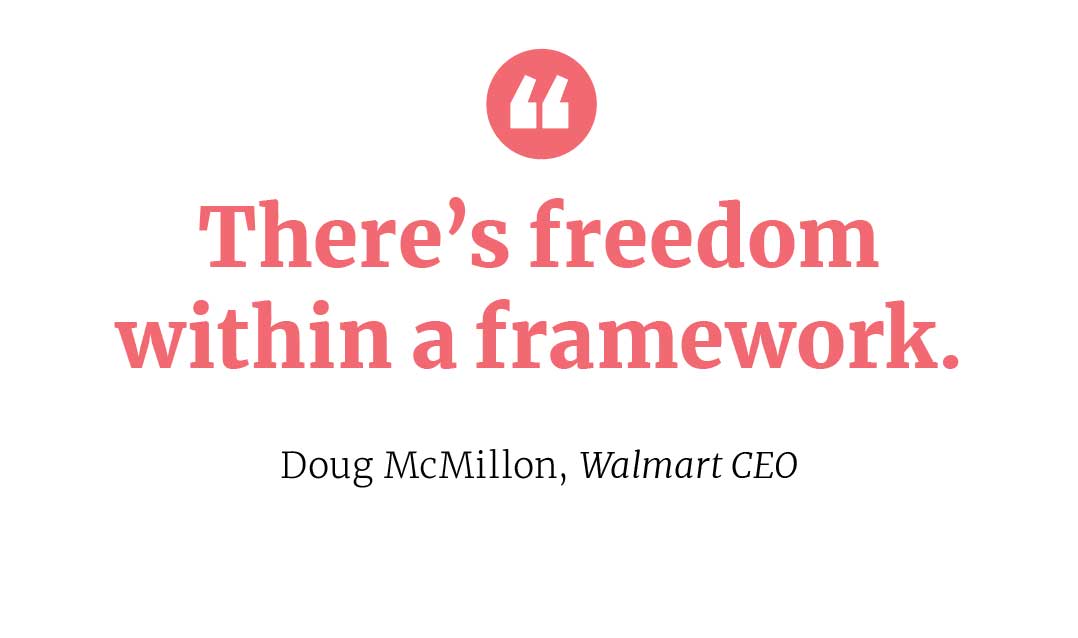
T h e r e ’ s f r e e d o m within a framework.
– Doug McMillon, Walmart CEO
When a process is implemented, it provides a structure and framework for how things should be done. However, within that framework, there may be room for interpretation or customization. In some situations, following a process exactly may not be necessary or even desirable. For example, in creative or entrepreneurial fields, where innovation and adaptability are highly valued, following a rigid process stifles creativity and limits potential innovation. Similarly, when dealing with complex or uncertain situations, a process may need to be adjusted or improvised to accommodate evolving environments.
Not following processes, or using processes simply as a guideline, creates a sense of ownership of the process — and the outcome — particularly when individuals or teams are given the flexibility to adapt and customize the process to fit their specific needs. Teams and individuals can feel a greater sense of ownership over the work they are doing; they can take pride in developing their unique approach to the task at hand. When individuals or teams have some control over the process, they can also feel a greater sense of responsibility and accountability for the outcomes. They have more of a stake in the success or failure of the project, which can drive them to work harder and take more initiative. This ownership breeds autonomy, one of the fundamental drivers of engagement, and can lead to greater job satisfaction. [For information about this, check out The Jabian Journal articles “Exploring the Dynamics of Employee Engagement,” Fall 2016, and “Autonomy and Engagement,” Fall 2018.]
Using processes as a guideline can also provide a clear structure for individuals or teams to follow, which can be helpful for managing complex tasks or projects. Having a defined process can reduce uncertainty and confusion, particularly in situations where there are many stakeholders or team members involved.
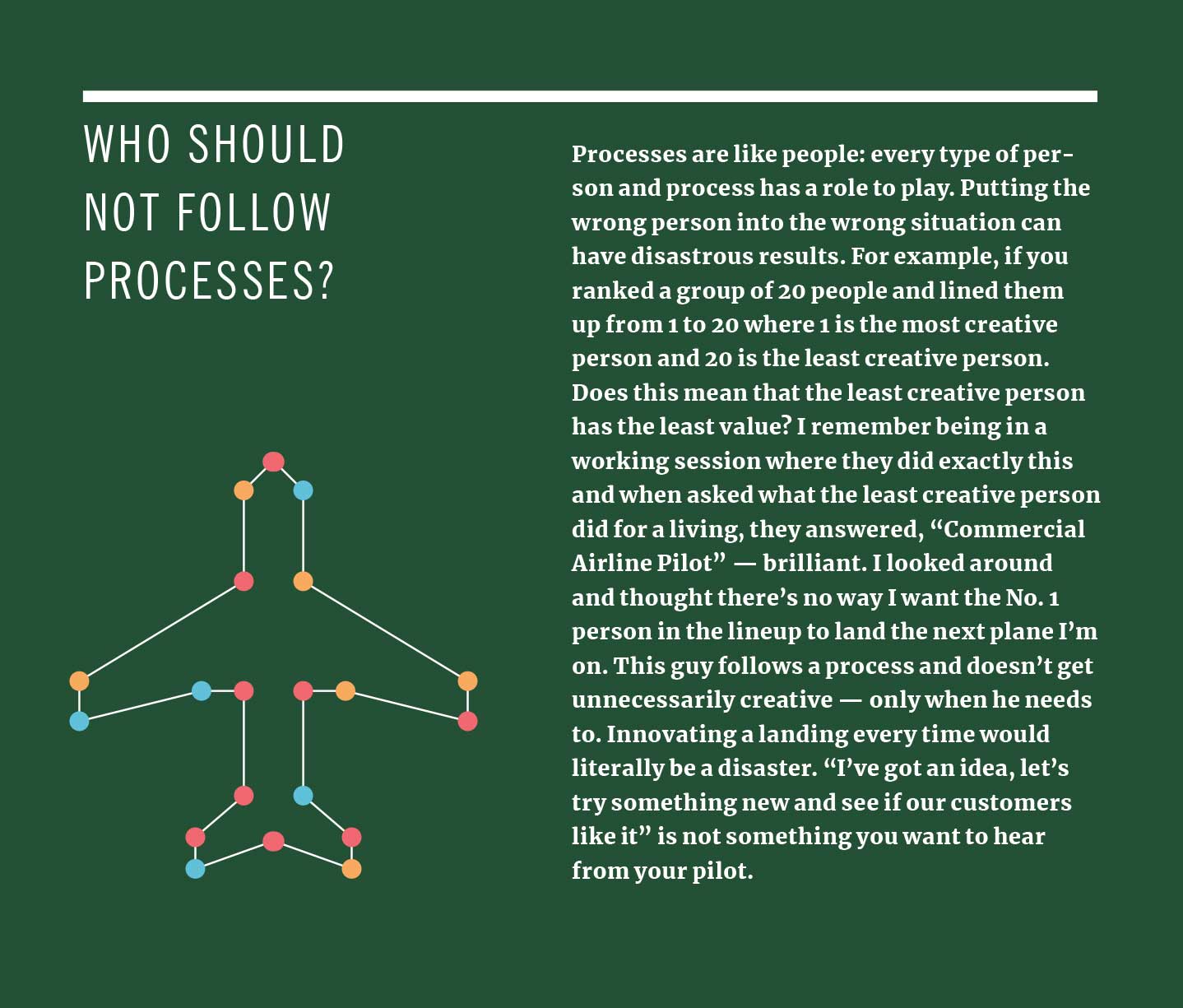
WHO SHOULD NOT FOLLOW PROCESSES?
Processes are like people: every type of person and process has a role to play. Putting the wrong person into the wrong situation can have disas- trous results. For example, if you ranked a group of 20 people and lined them up from 1 to 20 where 1 is the most creative person and 20 is the least creative person. Does this mean that the least creative person has the least value? I remember being in a working session where they did exactly this and when asked what the least creative person did for a living, they answered, “Commercial Airline Pilot” — brilliant. I looked around and thought there’s no way I want the No. 1 person in the lineup to land the next plane I’m on. This guy follows a process and doesn’t get unnecessarily creative — only when he needs to. Innovating a landing every time would literally be a disaster. “I’ve got an idea, let’s try something new and see if our customers like it” is not something you want to hear from your pilot.
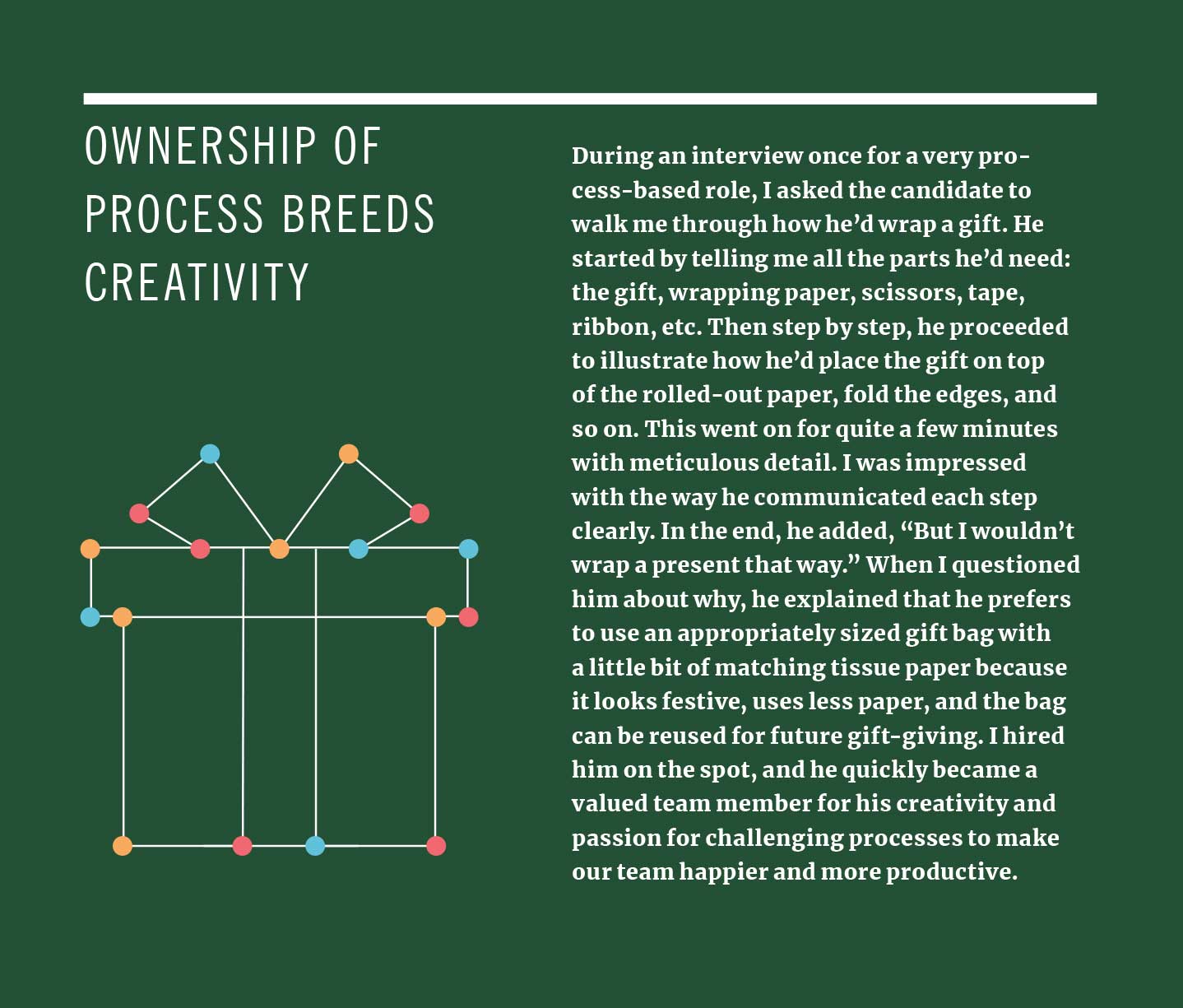
OWNERSHIP OF PROCESS BREEDS CREATIVITY
During an interview once for a very process-based role, I asked the candidate to walk me through how he’d wrap a gift. He started by telling me all the parts he’d need: the gift, wrapping paper, scissors, tape, ribbon, etc. Then step by step, he proceeded to illustrate how he’d place the gift on top of the rolled-out paper, fold the edges, and so on. This went on for quite a few minutes with meticulous detail. I was impressed with the way he communicated each step clearly. In the end, he added, “But I wouldn’t wrap a present that way.” When I questioned him about why, he explained that he prefers to use an appropriately sized gift bag with a little bit of matching tissue paper because it looks festive, uses less paper, and the bag can be reused for future gift-giving. I hired him on the spot, and he quickly became a valued team member for his creativ- ity and passion for challenging processes to make our team happier and more productive.
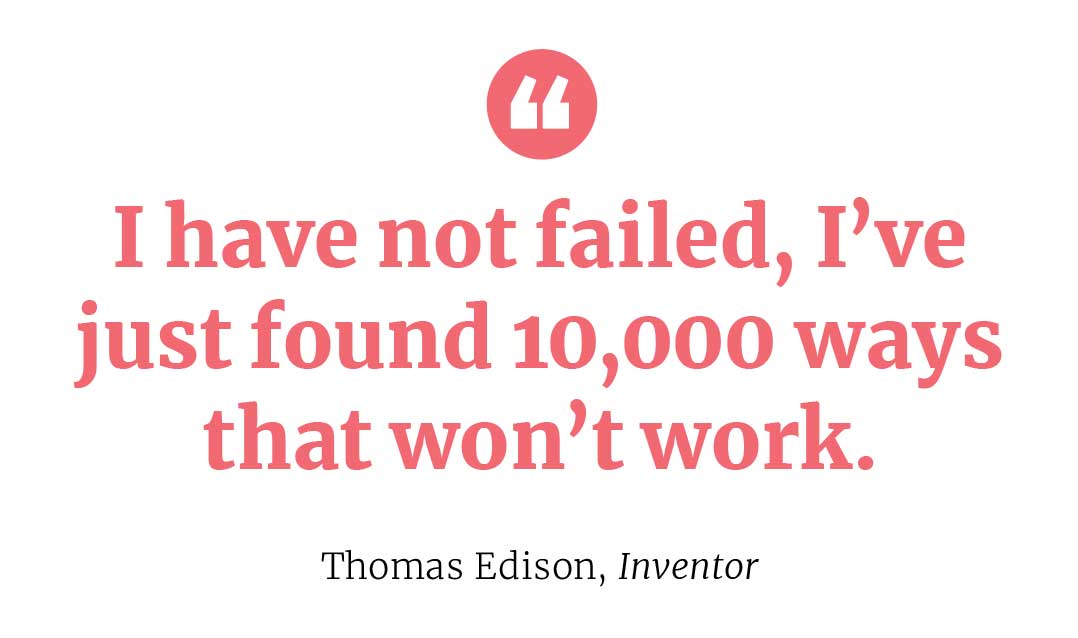
I h a v e n o t f a i l e d , I ’ v e just found 10,000 ways that won’t work.
– Thomas Edison, Inventor
However, it’s important to note that the level of ownership given to individuals or teams when following a process will depend on the specific context and goals of the project. In some cases, there may be strict guidelines that must be followed, and there may be limited room for interpretation or customization. When working in the health care or security industries, for instance, deviation from a set process is often not allowed, let alone encouraged.
Regardless of the level of autonomy given, it’s important for individuals or teams to understand the purpose and goals of the process they are following. By understanding the underlying principles and objectives of the process, individuals or teams can make informed decisions about how to adapt and customize the process to fit their specific needs. This can lead to greater buy-in and engagement from all stakeholders, as well as more successful outcomes.
When you need to determine if you need to follow a process — or if you can make it your own — consider your viability by taking our CAUSE questionnaire before you get started:
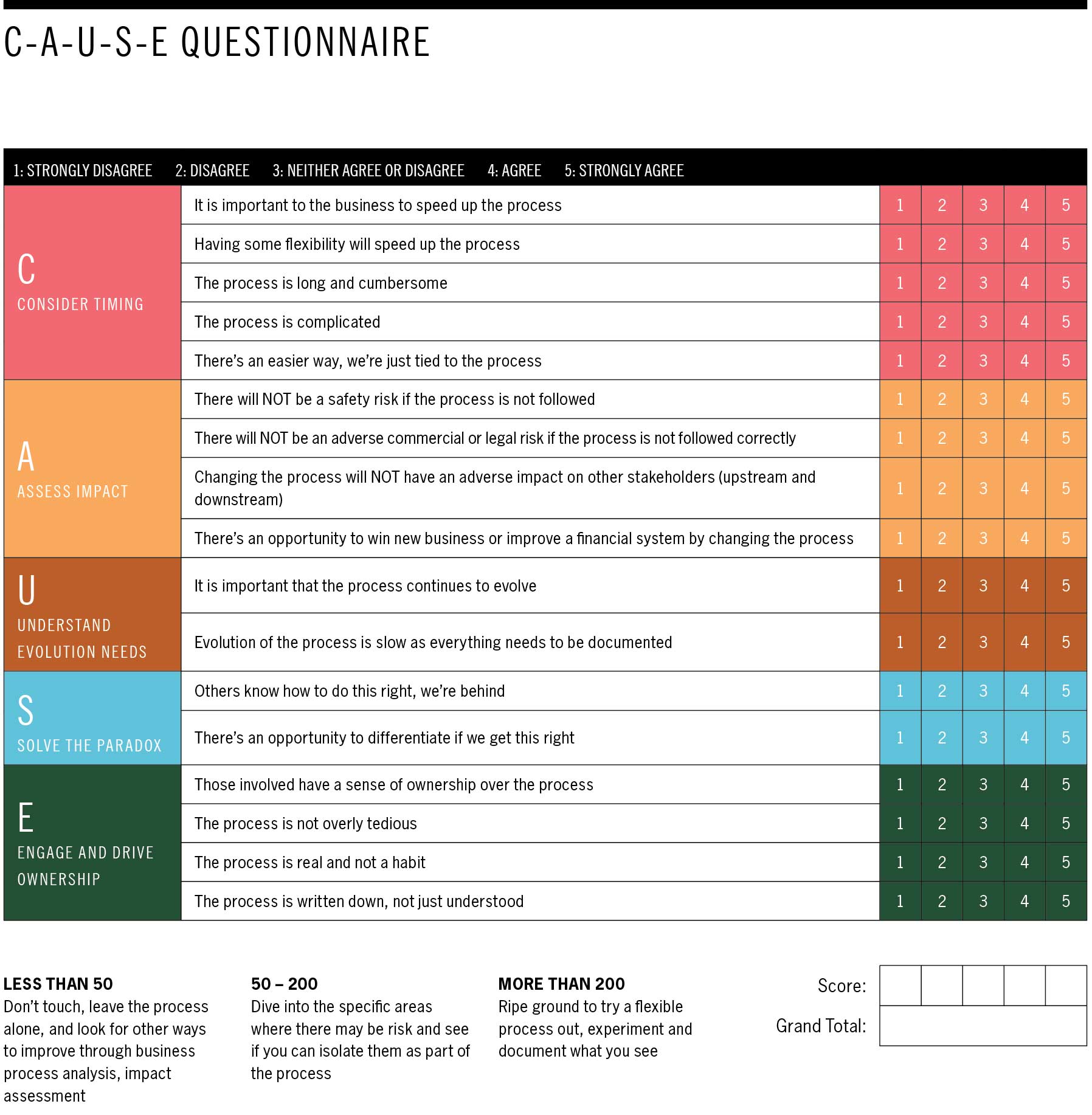
The traditional approach to organizational processes has long been based on rigid structures and strict adherence to established procedures. However, in today’s rapidly changing world, the need for flexibility has never been greater. It’s time to challenge the notion that people should adapt to processes and instead, they should be encouraged to create processes that adapt to people. Some argue that this approach undermines efficiency and creates chaos, but the reality is that rigid processes often hinder productivity and stifle innovation. The secret is communication of intended outcomes, controls, guard rails, and the ability to be flexible. It’s kind of like making a recipe: If you want to switch an ingredient for another as you have it on hand or prefer it, then you can and you should. It’s still the same recipe, just customized. The secret is getting the core of it right, making sure you don’t create something poisonous, making sure you deliver the food to the table on time, and ensuring the recipients are happy and full.
